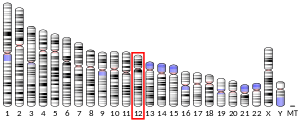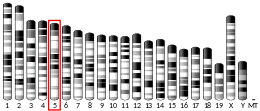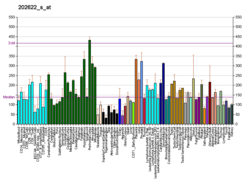Ataxin-2
Ataxin-2 is a protein that in humans is encoded by the ATXN2 gene.[5][6] Mutations in ATXN2 cause spinocerebellar ataxia type 2 (SCA2).
Protein structure
Ataxin-2 contains the following protein domains:[7]
- Two LSm domains, which likely allow it to bind RNA
- A PAM2 motif, predicted to associate with the poly(A)-binding protein
- A polyglutamine tract in some species (located near the amino terminal in primates and between the LSm domains in insects)[8]
A potential transcript variant, missing an internal coding exon, has been described; however, its full-length nature is not certain.[9]
Species, tissue, and subcellular distribution
ATXN2 is conserved across eukaryotes. Most vertebrates have two orthologs of the gene (called ATXN2 and ATXN2L in humans), with the exception of birds which only have one. Plant species have two to six ATXN2 orthologs.[8]
ATXN2 is ubiquitously expressed in different tissues. Within individual cells, it localizes to the Golgi apparatus and stress granules.[10]
Function
Ataxin-2 is involved in regulating mRNA translation through its interactions with the poly(A)-binding protein. It is also involved in the formation of stress granules and P-bodies, which also play roles in RNA regulation.[10]
Clinical significance
Spinocerebellar ataxia type 2 (SCA2)
The polyglutamine tract in human ataxin-2 is unstable and can expand as it is transmitted across generations. Normal alleles usually have 22 or 23 repeats, but can contain up to 31 repeats. Longer expansions can cause spinocerebellar ataxia type 2 (SCA2), a fatal progressive genetic disorder in which neurons degenerate in the cerebellum, inferior olive, pons, and other areas. Symptoms of SCA2 include ataxia (a loss of coordinated movements), parkinsonism, and dementia in some cases.[11] The disease allele usually contains 34-52 CAG repeats, but can contain as few as 32 or more than 100, and can expand in size when transmitted to successive generations. How the polyglutamine expansion in ataxin-2 leads to these symptoms is unknown.
Amyotrophic lateral sclerosis (ALS)
In 2010, work from Aaron Gitler and Nancy Bonini at the University of Pennsylvania discovered that intermediate-size CAG repeat expansions are significantly associated with risk for developing amyotrophic lateral sclerosis (Lou Gehrig's disease).[12]
References
- GRCh38: Ensembl release 89: ENSG00000204842 - Ensembl, May 2017
- GRCm38: Ensembl release 89: ENSMUSG00000042605 - Ensembl, May 2017
- "Human PubMed Reference:". National Center for Biotechnology Information, U.S. National Library of Medicine.
- "Mouse PubMed Reference:". National Center for Biotechnology Information, U.S. National Library of Medicine.
- Gispert S, Twells R, Orozco G, Brice A, Weber J, Heredero L, Scheufler K, Riley B, Allotey R, Nothers C (July 1993). "Chromosomal assignment of the second locus for autosomal dominant cerebellar ataxia (SCA2) to chromosome 12q23-24.1". Nature Genetics. 4 (3): 295–9. doi:10.1038/ng0793-295. PMID 8358438.
- Margolis RL, Abraham MR, Gatchell SB, Li SH, Kidwai AS, Breschel TS, Stine OC, Callahan C, McInnis MG, Ross CA (July 1997). "cDNAs with long CAG trinucleotide repeats from human brain". Human Genetics. 100 (1): 114–22. doi:10.1007/s004390050476. PMID 9225980.
- Albrecht M, Golatta M, Wüllner U, Lengauer T (August 2004). "Structural and functional analysis of ataxin-2 and ataxin-3". European Journal of Biochemistry. 271 (15): 3155–70. doi:10.1111/j.1432-1033.2004.04245.x. PMID 15265035.
- Jiménez-López D, Guzmán P (July 2014). "Insights into the evolution and domain structure of Ataxin-2 proteins across eukaryotes". BMC Research Notes. 7: 453. doi:10.1186/1756-0500-7-453. PMC 4105795. PMID 25027299.
- "Entrez Gene: ATXN2 ataxin 2".
- Orr HT (April 2012). "Cell biology of spinocerebellar ataxia". The Journal of Cell Biology. 197 (2): 167–77. doi:10.1083/jcb.201105092. PMC 3328388. PMID 22508507.
- Reference, Genetics Home. "SCA2". Genetics Home Reference. Retrieved 2018-01-11.
- Elden AC, Kim HJ, Hart MP, Chen-Plotkin AS, Johnson BS, Fang X, Armakola M, Geser F, Greene R, Lu MM, Padmanabhan A, Clay-Falcone D, McCluskey L, Elman L, Juhr D, Gruber PJ, Rüb U, Auburger G, Trojanowski JQ, Lee VM, Van Deerlin VM, Bonini NM, Gitler AD (August 2010). "Ataxin-2 intermediate-length polyglutamine expansions are associated with increased risk for ALS". Nature. 466 (7310): 1069–75. doi:10.1038/nature09320. PMC 2965417. PMID 20740007.
Further reading
- Stevanin G, Dürr A, Brice A (January 2000). "Clinical and molecular advances in autosomal dominant cerebellar ataxias: from genotype to phenotype and physiopathology". European Journal of Human Genetics. 8 (1): 4–18. doi:10.1038/sj.ejhg.5200403. PMID 10713882.
- Pulst SM, Nechiporuk A, Nechiporuk T, Gispert S, Chen XN, Lopes-Cendes I, Pearlman S, Starkman S, Orozco-Diaz G, Lunkes A, DeJong P, Rouleau GA, Auburger G, Korenberg JR, Figueroa C, Sahba S (November 1996). "Moderate expansion of a normally biallelic trinucleotide repeat in spinocerebellar ataxia type 2". Nature Genetics. 14 (3): 269–76. doi:10.1038/ng1196-269. PMID 8896555.
- Sanpei K, Takano H, Igarashi S, Sato T, Oyake M, Sasaki H, Wakisaka A, Tashiro K, Ishida Y, Ikeuchi T, Koide R, Saito M, Sato A, Tanaka T, Hanyu S, Takiyama Y, Nishizawa M, Shimizu N, Nomura Y, Segawa M, Iwabuchi K, Eguchi I, Tanaka H, Takahashi H, Tsuji S (November 1996). "Identification of the spinocerebellar ataxia type 2 gene using a direct identification of repeat expansion and cloning technique, DIRECT". Nature Genetics. 14 (3): 277–84. doi:10.1038/ng1196-277. PMID 8896556.
- Imbert G, Saudou F, Yvert G, Devys D, Trottier Y, Garnier JM, Weber C, Mandel JL, Cancel G, Abbas N, Dürr A, Didierjean O, Stevanin G, Agid Y, Brice A (November 1996). "Cloning of the gene for spinocerebellar ataxia 2 reveals a locus with high sensitivity to expanded CAG/glutamine repeats". Nature Genetics. 14 (3): 285–91. doi:10.1038/ng1196-285. PMID 8896557.
- Sahba S, Nechiporuk A, Figueroa KP, Nechiporuk T, Pulst SM (February 1998). "Genomic structure of the human gene for spinocerebellar ataxia type 2 (SCA2) on chromosome 12q24.1". Genomics. 47 (3): 359–64. doi:10.1006/geno.1997.5131. PMID 9480749.
- Huynh DP, Del Bigio MR, Ho DH, Pulst SM (February 1999). "Expression of ataxin-2 in brains from normal individuals and patients with Alzheimer's disease and spinocerebellar ataxia 2". Annals of Neurology. 45 (2): 232–41. doi:10.1002/1531-8249(199902)45:2<232::AID-ANA14>3.0.CO;2-7. PMID 9989626.
- Huynh DP, Figueroa K, Hoang N, Pulst SM (September 2000). "Nuclear localization or inclusion body formation of ataxin-2 are not necessary for SCA2 pathogenesis in mouse or human". Nature Genetics. 26 (1): 44–50. doi:10.1038/79162. PMID 10973246.
- Affaitati A, de Cristofaro T, Feliciello A, Varrone S (April 2001). "Identification of alternative splicing of spinocerebellar ataxia type 2 gene". Gene. 267 (1): 89–93. doi:10.1016/S0378-1119(01)00402-4. PMID 11311558.
- Kiehl TR, Shibata H, Vo T, Huynh DP, Pulst SM (August 2001). "Identification and expression of a mouse ortholog of A2BP1". Mammalian Genome. 12 (8): 595–601. doi:10.1007/s00335-001-2056-4. PMID 11471052.
- Choudhry S, Mukerji M, Srivastava AK, Jain S, Brahmachari SK (October 2001). "CAG repeat instability at SCA2 locus: anchoring CAA interruptions and linked single nucleotide polymorphisms". Human Molecular Genetics. 10 (21): 2437–46. doi:10.1093/hmg/10.21.2437. PMID 11689490.
- Pang JT, Giunti P, Chamberlain S, An SF, Vitaliani R, Scaravilli T, Martinian L, Wood NW, Scaravilli F, Ansorge O (March 2002). "Neuronal intranuclear inclusions in SCA2: a genetic, morphological and immunohistochemical study of two cases". Brain. 125 (Pt 3): 656–63. doi:10.1093/brain/awf060. PMID 11872620.
- Satterfield TF, Jackson SM, Pallanck LJ (December 2002). "A Drosophila homolog of the polyglutamine disease gene SCA2 is a dosage-sensitive regulator of actin filament formation". Genetics. 162 (4): 1687–702. PMC 1462369. PMID 12524342.
- Wiedemeyer R, Westermann F, Wittke I, Nowock J, Schwab M (January 2003). "Ataxin-2 promotes apoptosis of human neuroblastoma cells". Oncogene. 22 (3): 401–11. doi:10.1038/sj.onc.1206150. PMID 12545161.
- Payami H, Nutt J, Gancher S, Bird T, McNeal MG, Seltzer WK, Hussey J, Lockhart P, Gwinn-Hardy K, Singleton AA, Singleton AB, Hardy J, Farrer M (April 2003). "SCA2 may present as levodopa-responsive parkinsonism". Movement Disorders. 18 (4): 425–9. doi:10.1002/mds.10375. PMID 12671950.
- Svetel M, Djarmati A, Dragasević N, Savić D, Culjković B, Romac S, Kostić VS (September 2003). "SCA2 and SCA3 mutations in young-onset dopa-responsive parkinsonism". European Journal of Neurology. 10 (5): 597. doi:10.1046/j.1468-1331.2003.00671.x. PMID 12940846.
- Brenneis C, Bösch SM, Schocke M, Wenning GK, Poewe W (October 2003). "Atrophy pattern in SCA2 determined by voxel-based morphometry". NeuroReport. 14 (14): 1799–802. doi:10.1097/00001756-200310060-00008. PMID 14534423.
External links
- GeneReviews/NIH/NCBI/UW entry on Spinocerebellar Ataxia Type 2
- Human ATXN2 genome location and ATXN2 gene details page in the UCSC Genome Browser.




